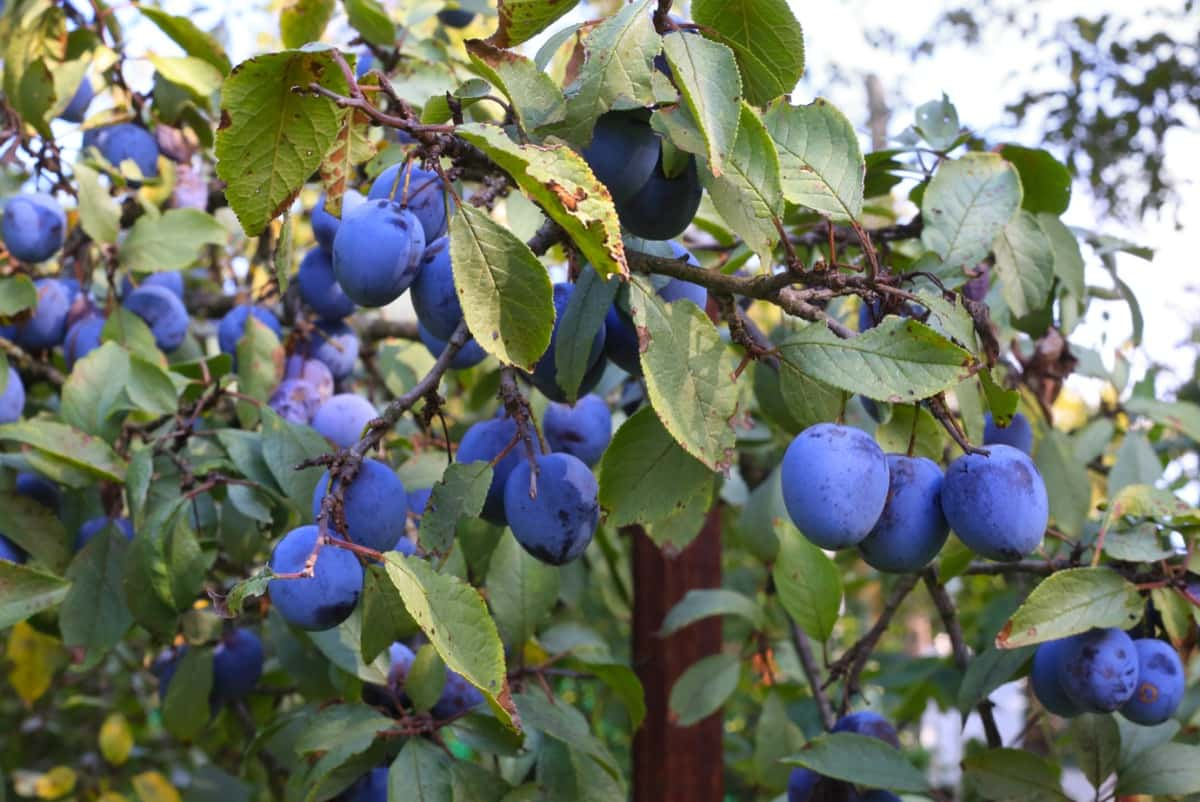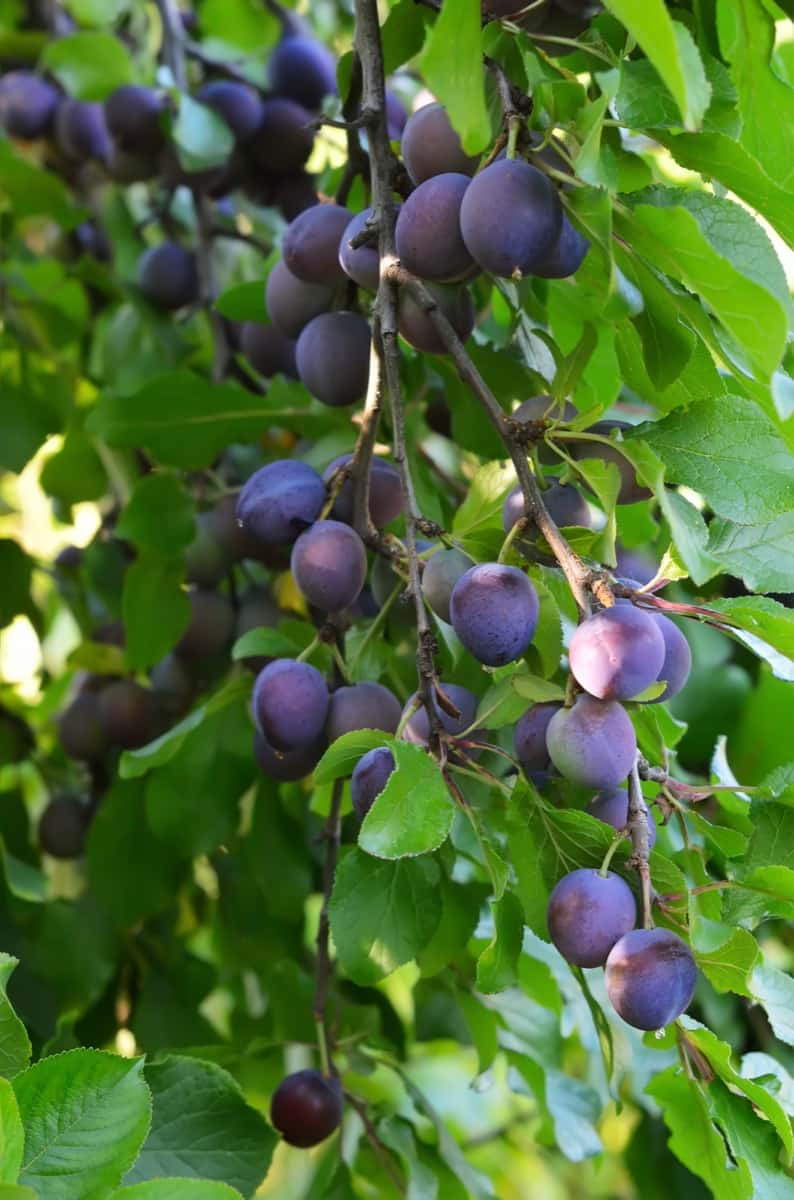Fertilizing potted plum trees is essential for their optimal growth and fruit production. Plum trees, whether grown in the ground or containers, require regular nutrients to thrive. When it comes to fertilizing potted plum trees, a well-balanced, slow-release fertilizer specifically formulated for fruit trees is recommended. Proper fertilization will help potted plum trees yield bountiful and delicious fruit.

Fertilizing Potted Plum Trees
Organic Fertilizers for Plum Trees in Pots: Nurturing Your Plants Naturally
Manure
Another excellent organic fertilizer for plum trees is well-aged animal manure. Chicken, cow, or horse manure are commonly used in gardens. However, it is important to ensure that the manure has been properly composted or aged to avoid burning the roots of your plum tree. Apply a layer of manure around the tree’s base and lightly mix it into the soil. This will help provide essential nutrients and improve the soil structure.
Worm Castings
Worm castings, also known as vermicompost, are the organic matter left behind by earthworms after they digest organic material. They are rich in essential nutrients and beneficial microorganisms that aid plant growth. Apply worm castings around the base of your plum tree and gently work it into the soil. This will help improve soil fertility and enhance the overall health of your plum tree.
Natural Fertilizers for Plum Trees in Pots: for Environmentally-friendly Options
Fish Emulsion
Fish emulsion is a liquid fertilizer from whole fish or fish byproducts. It is rich in NPK, essential for plant growth. Dilute fish emulsion according to the manufacturer’s instructions and apply it to the soil around your plum tree. This will immediately boost nutrients and promote healthy foliage and fruit development.
Seaweed Extract
Seaweed extract is a natural fertilizer derived from seaweed and a great source of trace minerals and growth-promoting hormones. It can be purchased in liquid form and easily applied to the soil around your plum tree. Seaweed extract enhances root development, improves nutrient uptake, and increases resistance to environmental stressors.
Homemade Fertilizers for Plum Trees in Pots: DIY Solutions for Optimal Plant Health
Homemade fertilizers offer a cost-effective and customizable solution for nurturing plum trees in pots. These DIY options can be tailored to suit the specific requirements of your plants, ensuring optimal health and growth. One such homemade fertilizer is a banana peel solution. Bananas peels are rich in potassium, which is vital for fruit production. To make this fertilizer, chop banana peels and soak them in water for a few days.
In case you missed it: All About Yellow Plum: Origin, Varieties, Benefits, and Growing

The water will absorb the nutrients from the peels, creating a nutrient-rich liquid that can be used to water your plum trees. Another DIY fertilizer option is eggshell tea. Eggshells are a great calcium source, promoting strong root development in plants. To make this fertilizer, crush eggshells and steep them in water for several days. The resulting liquid can then water your plum trees, boosting their calcium.
NPK Ratios and Their Importance in Selecting Fertilizers for Plum Trees in Pots
NPK ratios are crucial in selecting fertilizers for plum trees grown in pots. NPK stands for nitrogen (N), phosphorus (P), and potassium (K), which are the three essential elements needed for plant growth and development. When selecting fertilizers for plum trees in pots, it is important to consider their specific needs.
Young trees typically require higher phosphorus (P) levels to support root development, while mature trees may benefit from higher potassium (K) levels for fruit production and overall health. It is recommended to choose a fertilizer with an NPK ratio that suits the specific growth stage of the plum tree. A balanced ratio such as 10-10-10 can be appropriate for young trees, while a ratio like 5-10-20 can benefit mature trees.
Slow-release Fertilizers: Enhancing Nutrient Availability for Plum Trees in Pots
One advantage of using Natural slow-release fertilizers is that they are produced from natural sources, such as composted manure, bone meal, and fish emulsion. This makes them environmentally friendly and safe for the plants and the surrounding ecosystem. Using slow-release fertilizers, plum trees in pots can benefit from a consistent supply of nutrients, promoting healthy growth and development.
The slow-release mechanism ensures that the nutrients are released in sync with the plant’s needs, preventing over-fertilization or nutrient leaching. In addition to enhancing nutrient availability, organic slow-release fertilizers also improve soil fertility. As the fertilizers break down, they enrich the soil with organic matter, enhancing its structure, water-holding capacity, and nutrient-retention ability. This, in turn, creates a favorable environment for plum trees in pots to thrive.
pH Levels and Fertilizer Selection for Plum Trees in Pots: For Balanced Soil Environment
The ideal pH range for plum trees is slightly acidic, ranging from 6.0 to 6.5. This acidity level allows optimal nutrient absorption and availability, promoting vigorous growth and fruit production. Regularly inspect the pH of the soil to maintain within the desired range. pH testing kits are widely available and can help you determine the acidity levels of your soil.
To adjust the pH level, you can use various amendments. If the soil is too alkaline (pH above 6.5), you can lower the pH by applying elemental sulfur or aluminum sulfate. These amendments gradually acidify the soil over time. On the other hand, if the soil is too acidic (pH below 6.0), you can increase the pH by adding agricultural lime or dolomitic lime. These amendments help to raise the pH and reduce acidity.
The Importance of Timing: When to Apply Fertilizer to Plum Trees in Pots
It is best to apply fertilizer during the active growing season, which typically begins in early spring and continues through summer. This is when the trees have the greatest nutrient demands. Applying fertilizer too early or too late can produce suboptimal growth and fruit. It is recommended to follow the instructions on the fertilizer package regarding the frequency and quantity of application.
In case you missed it: Growing Japanese Plum from Seed: Seed Germination, Planting, and Care

Additionally, regular monitoring of the tree’s growth and health can help determine if any adjustments to the fertilizer schedule are needed. Proper timing of fertilizer application ensures the plum trees receive the necessary nutrients for optimal growth and fruit development.
How to Apply Fertilizer to Plum Trees in Pots: Techniques for Maximum Effectiveness
To effectively apply fertilizer to plum trees in pots, follow these techniques for maximum effectiveness. First, choose a balanced fertilizer with equal nitrogen, phosphorus, and potassium. Apply the fertilizer during the active growth, from spring to early fall. Make sure the potting soil is moist before applying the fertilizer.
Sprinkle a thin layer of fertilizer around the tree’s base, avoiding direct contact with the trunk. Use a slow-release fertilizer to provide consistent nutrients over time. Water the tree after fertilization to help it absorb the nutrients. Repeat this process every four to six weeks for optimal growth and fruit production.
Water-soluble Fertilizers for Potted Plum Trees
Water-soluble fertilizers are an ideal choice for potted plum trees. These fertilizers are designed to dissolve easily in water, allowing the nutrients readily available to the tree’s roots. Potted plum trees have limited access to nutrients in the surrounding soil, so using water-soluble fertilizers helps ensure they receive the necessary nutrients for healthy growth.
Typically, these fertilizers contain a balanced mix of essential nutrients like nitrogen, phosphorus, potassium, and other micronutrients. They can be applied by diluting the fertilizer in water and watering the tree with the solution. Regular water-soluble fertilizers can promote vigorous growth, increased fruit production, and overall plant health.
In case you missed it: How to Prune Plum Trees: Best Time to Trim, Tools and Techniques to Cut Back Plum Trees

Conclusion
Regular fertilization is essential for potted plum trees to maintain their vigor and productivity. Using organic, natural, and homemade fertilizers with a balanced NPK ratio, applying them at the right time, and following proper application techniques, you can provide the necessary nutrients for your potted plum trees to thrive.
- Feed Your Flock for Less: Top 10 Tips to Save on Chicken Feed
- Ultimate Guide to Ossabaw Island Hog: Breeding, Raising, Diet, and Care
- Hatching Answers: The Top 10 Reasons Your Chickens Aren’t Laying Eggs
- Eggs and Economics: Breaking Down the Cost of Raising Backyard Chickens
- Defend Your Greens: Proven Methods to Keep Iguanas Out of Your Garden
- Ultimate Guide to Cinnamon Queen Chicken: A Comprehensive Guide for Beginners
- Ultimate Guide to California Tan Chicken: Breeding, Raising, Diet, Egg-Production and Care
- Ultimate Guide to Marsh Daisy Chicken: Breeding, Raising, Diet, and Care
- 10 Types of Chicken Farming Businesses You Can Start for Profits